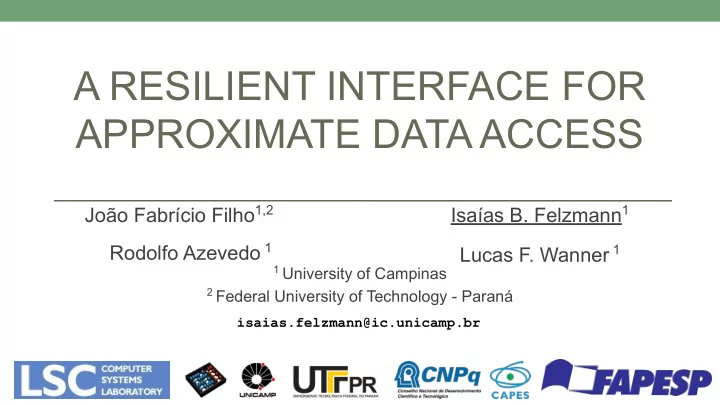

A RESILIENT INTERFACE FOR APPROXIMATE DATA ACCESS João Fabrício Filho 1,2 Isaías B. Felzmann 1 Rodolfo Azevedo 1 Lucas F. Wanner 1 1 University of Campinas 2 Federal University of Technology - Paraná isaias.felzmann@ic.unicamp.br
Trading power • Problem: We want to save power! • Solution 1: Make hardware smaller… Physics says “not anymore”. • • Solution 2: Trade power for Performance… Large portions of hardware kept off - Dark Silicon • • Solution 3: Trade power for Quality… Not every application need a perfect result • Approximate Computing • 2
Memory approximation • SRAM - Voltage Scaling • Reduces noise margins on read/write operations • Exposes data to errors • Error rate increases for lower voltage levels • Exponentially! (Wang & Calhoun, TVLSI’2011) • Alternatives: • DRAM Refresh rate • Precision scaling 3
Classifying Execution Crashes Data Crash • Illegal memory access while fetching data Control Crash • Illegal memory access while fetching instruction Timeout • Application fails to converge 4
AxRAM: Preventing crashes • Lightweight implementation Avoid checkpoint & rollback • Avoid recovery software routines • • Find upper bounds for error rate And lower bounds for energy • • Minimal user intervention for control Less code to maintain • No expert knowledge required • 5
Correcting Data Crashes 00011111 00001000 01001000 00001000 6
Preventing Control Crashes: Stack protection • Stores some control pointers • E.g. function return addresses • Also stores other critical data • Local variables, loop control indexes • Stack addresses are identifiable without user intervention 7
How to protect? • Architectural model • Voltage selector for each memory bank • Voltage regulator to control approximate state • Memory-mapped control registers 8
Experiments Memory-bound 2mm CPU-bound Signal processing bunzip nbody jpeg bzip mandelbrot fft dijkstra spectralnorm reg_detect floyd-warshall qsort • Error rates from 10 -9 to 10 -4 • Errors are probabilistic • All results compared to unprotected scenario 9
Execution Crashes Data crashes % of executions that crashed Flow crashes Timeouts 10
Quality 11
Quality/Energy 12
Probability of Quality < 80% 13
Relative Energy, Quality > 80% 14
Final Remarks • Most quality depreciation results from crashes • Applications tolerate higher error rates when crashes are mitigated • AxRAM access protection prevents application crashes Higher energy savings • Even higher if compared to traditional SW techniques • 15
Thank You! varchc.github.io/sbesc/ isaias.felzmann@ic.unicamp.br 16
Recommend
More recommend